5th-Grade math time worksheets: Elapsed time word problems and more
Have your 5th graders mastered the different aspects of clock reading? If not, then this article is for you. This article will share a collection of 5th-grade math time worksheets covering every common time concept in Grade 5, elapsed time word problems, and more. Also, we'll provide you with tips for solving time word problems effectively and how to incorporate real-life examples in time word problems.
-
And as a bonus, we'll also tell you where to find additional resources for practicing time skills.
Time flies with these 5th-Grade math time worksheets and word problems: Keep moving on!
Time flies when you're having fun, and what better way to make math enjoyable than with these 5th-grade math time worksheets and word problems? Whether your child needs some extra practice or wants to stay ahead of the curve, these engaging exercises are designed to keep them moving on in their math skills.
From calculating elapsed time to solving real-world time-related scenarios, these worksheets offer a variety of challenges that will sharpen their critical thinking and problem-solving abilities. With vibrant illustrations and clear instructions, these worksheets make learning about time a breeze. So, say goodbye to boring math drills and hello to a fun-filled journey through the world of time.
Get ready to watch your child's confidence soar as they conquer time-related math concepts and become a master of the clock. It's time to embrace the learning adventure and keep those math skills ticking!
-
BROWSE THE WEBSITE
-
DOWNLOAD FREE WORKSHEETS
-
-
5th GRADE MATH TOPICS
- Number sense
- Addition and subtraction
- Multiplication
- Division
- Exponents
- Number theory
- Decimals
- Add & subtract decimals
- Multiply decimals
- Divide decimals
- Fractions & mixed numbers
- Add & subtract fractions
- Multiply fractions
- Divide fractions
- Mixed operations
- Problems solving
- Ratios and rates
- Percentages
- Money Math
- Number sequences
- Coordinate graph
- Variable expressions
- Data and Graphs
- Probability and statistics
- Telling time
- Unit of measurements
- 2D figures
- Triangles & quadrilaterals
- Symmetry & transformations
- 3D figures
- Geometric measurements
-
-
Converting units of time: seconds minutes and hours
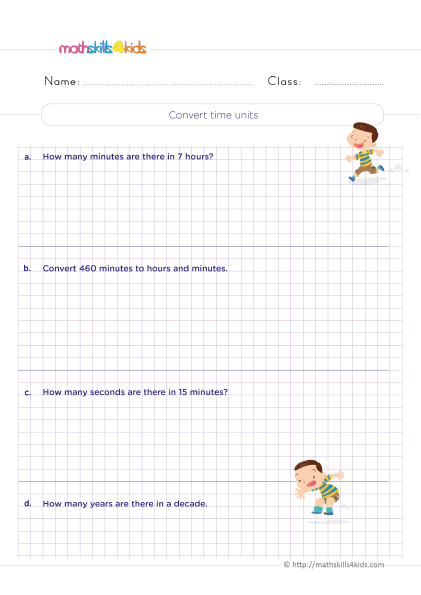 Print it...
Print it...
-
Adding and subtracting mixed time units practice
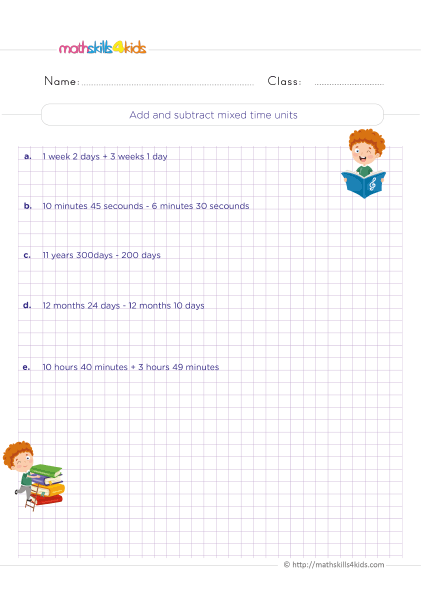 Print it...
Print it...
-
Time zones
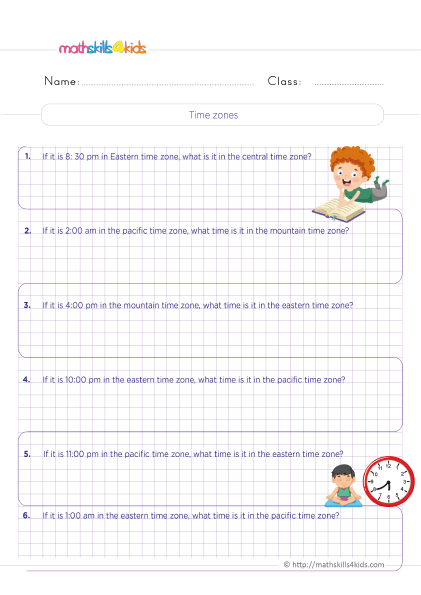 Print it...
Print it...
-
Elapsed time
 Print it...
Print it...
-
Time word problems: findind start and end time
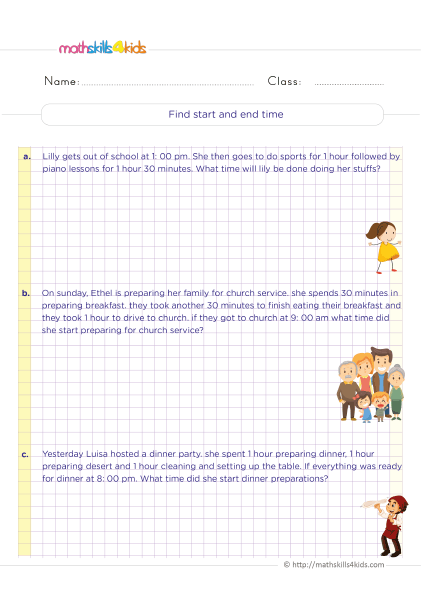 Print it...
Print it...
-
Time problems involving daily routines, schedules and timelines
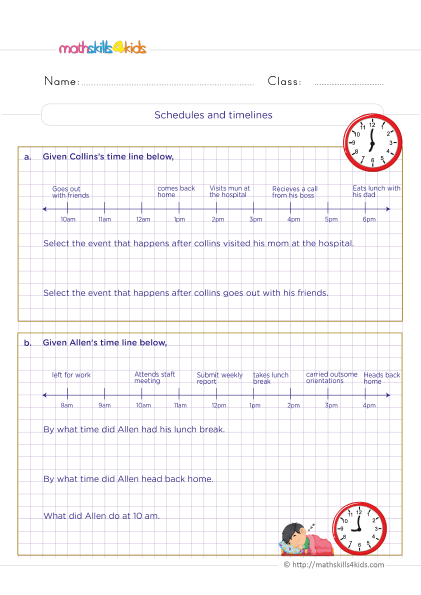 Print it...
Print it...
-
Converting units of time: seconds minutes and hours
-
Buying is supporting us!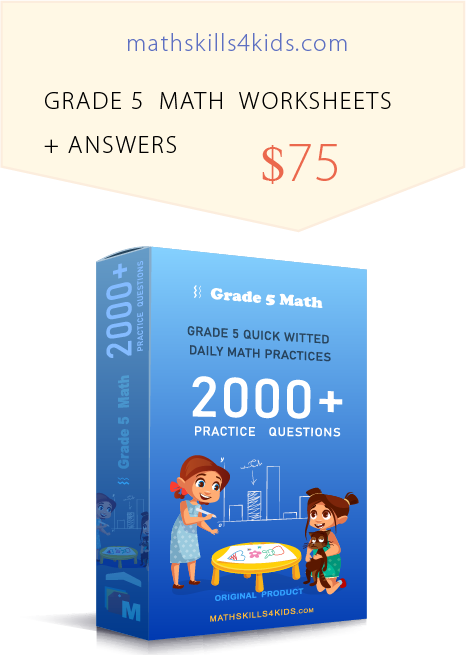
Buy Now...
-
-
Importance of practicing time skills in 5th grade
As students progress through their academic journey, the importance of mastering foundational math concepts becomes increasingly evident. In 5th grade, one of the key areas of focus is time. Time is a fundamental concept that children encounter in their daily lives, from planning their schedules to understanding the passage of time during different activities. By practicing time skills in 5th grade, students develop a strong foundation in this area, which becomes essential as they tackle more advanced math topics in the future.
Practicing time skills helps students become proficient in telling time and enables them to solve problems involving time intervals, elapsed time, and real-world scenarios. These skills are relevant in math and applicable in various aspects of life, such as managing time effectively, understanding schedules, and making informed decisions based on time-related information. Therefore, dedicating time to practicing time skills in 5th grade sets the stage for future success and prepares students for future challenges.
-
Common time concepts covered in 5th grade
In 5th grade, students delve deeper into the world of time and encounter various concepts that expand their understanding of this fundamental aspect. Some of the common time concepts covered in 5th grade include:
- Telling Time: Students learn to read analog and digital clocks, understand the relationship between hours, minutes, and seconds, and identify different clock parts.
- Elapsed Time: Students learn to calculate the time between two given points, considering hours, minutes, and seconds. They also learn to solve elapsed time problems involving real-life scenarios.
- Time Intervals: Students explore the concept of time intervals and learn to represent them in different units, such as hours, minutes, and seconds. They also practice converting between different units of time.
- Time Word Problems: Students apply their understanding of time concepts to solve word problems that involve real-life scenarios. These problems require critical thinking and problem-solving skills to determine the correct time calculations.
By mastering these common time concepts, students develop a solid foundation in time-related math skills, which they can build upon in advanced grades. Providing them with ample opportunities to practice and reinforce these concepts through engaging and interactive activities is essential.
-
Mathskills4kids’ 5th Grade math time worksheets
Mathskills4kids’ 5th Grade math time worksheets are valuable for providing students with focused practice on specific time concepts. These worksheets offer a structured format allowing students to apply their knowledge and skills systematically. With a wide range of time worksheets available for 5th graders, you can choose the ones that cater to your child's specific needs and learning style.
Mathskills4kids’ 5th Grade math time worksheets typically include various exercises such as:
- Reading Analog and Digital Clocks: These worksheets provide practice in reading and interpreting analog and digital clocks. Students must identify and represent the time shown on different clocks in analog and digital formats.
- Elapsed Time: Elapsed time worksheets challenge students to calculate the time between two given points. They may be presented with scenarios involving real-life activities or events, requiring them to determine the duration of time that has elapsed.
- Time Intervals: Time interval worksheets focus on developing students' understanding of time intervals and their ability to represent them in different units. Students may be asked to convert time intervals between hours, minutes, and seconds, or vice versa.
- Word Problems: Word problem worksheets present students with real-life scenarios that require them to apply their time-related math skills. These problems may involve determining start or end times, calculating elapsed time, or comparing durations of different activities.
By incorporating a variety of time worksheets into your child's math practice routine, you can provide them with targeted exercises that reinforce specific time concepts. This approach helps them understand time more deeply and enhances their problem-solving abilities.
-
Word problems involving time in 5th-grade math
Word problems are essential to 5th-grade math as they require students to apply their knowledge and skills to real-life situations. With time-related word problems, students are presented with scenarios that involve time calculations and require critical thinking to arrive at the correct answers. Solving these word problems reinforces time concepts and enhances students' problem-solving and analytical skills.
Here are a few examples of word problems involving time in 5th-grade math that students may encounter:
- Maya started baking cookies at 3:45 p.m. She baked for 1 hour and 30 minutes. What time did she finish baking?
- Emma wants to go swimming for 2 hours and 45 minutes. If she starts at 10:00 a.m., what time will she finish?
- The school bus picks up Jack at his house at 7:15 a.m. It takes him 30 minutes to get ready. What time should Jack wake up to catch the bus?
- Sarah went to the park at 2:30 p.m. She played for 1 hour and 15 minutes. What time did she leave the park?
To solve time word problems effectively, students should follow a systematic approach that involves analyzing the given information, identifying the unknowns, and choosing the appropriate time calculations. By breaking down the problem into smaller steps, students can simplify the process and arrive at the correct answers. Let's explore some tips for solving time word problems effectively.
-
Tips for solving time word problems effectively
Solving time word problems can be challenging for students, but they can confidently tackle these problems with the right strategies. Here are some tips to help students solve time word problems effectively:
- Read the problem carefully: Read the problem and identify the key information about time. Pay attention to the given start or end times, durations, and any other time-related details mentioned in the problem.
- Identify the unknowns: Determine what needs to be calculated or found in the problem. Is it the start time, end time, duration, or something else? Identify the unknowns to avoid confusion during the calculation process.
- Convert to a consistent time format: If the problem involves analog and digital time formats, convert them to a consistent format to simplify the calculations. For example, convert analog time to digital format or vice versa.
- Break down the problem: Break down the problem into smaller steps or intervals if necessary. This can help students organize their thoughts and make the problem more manageable. For example, if the problem involves multiple activities with different durations, consider solving each activity separately before combining the results.
- Use visual aids: Visual aids such as number lines or diagrams can help understand the problem and visualize the time intervals. Encourage students to draw diagrams or use number lines to represent the information and track the time calculations.
- Practice estimation: Estimation can be a helpful strategy for checking the reasonableness of the answers. Encourage students to estimate the answer before performing the calculations. If the estimated answer significantly differs from the calculated answer, they can review their work and identify potential errors.
By following these tips and practicing regularly, students can develop their problem-solving skills and become more confident in tackling time-word problems. Using real-life examples of these problems further enhances their understanding and makes the learning experience more engaging.
-
Incorporating real-life examples in time word problems
One effective way to engage students in time word problems is by incorporating real-life examples. By presenting problems that reflect situations they can relate to, students become more invested in problem-solving and develop a deeper understanding of time concepts.
Real-life examples make the problems more interesting and help students see the practical applications of time-related math skills.
Here are a few examples of time word problems that incorporate real-life scenarios:
- John goes to the gym every day at 5:30 p.m. He spends 1 hour and 15 minutes at the gym. What time does he finish his workout?
- Lisa has a piano lesson at 4:45 p.m. The lesson lasts for 45 minutes. What time will she finish her lesson?
- Tom starts his homework at 7:00 p.m. He works for 1 hour and 30 minutes. What time will he finish his homework?
Using real-life scenarios, students can connect the abstract concept of time with their everyday experiences, making the learning process more meaningful. This approach encourages critical thinking as students analyze the information and apply their time-related math skills to solve the problems.
It also fosters a deeper understanding of time concepts and prepares students for real-world situations where time calculations are necessary.
-
Interactive and engaging time activities for 5th graders
In addition to Mathskills4kids’ 5th Grade time worksheets and elapsed time word problems, incorporating interactive and engaging activities can further enhance students' understanding of time concepts. These activities provide a hands-on approach that allows students to explore time fun and interactively. Here are some interactive time activities for 5th graders:
- Clock Puzzles: Create puzzles that require students to match analog and digital representations of time. This activity helps reinforce their ability to read and interpret different clock formats.
- Time Bingo: Create a bingo game where students have to match time intervals or time-related phrases to the corresponding analog or digital time representation on their bingo cards. This activity helps improve their recognition of time intervals and reinforces their ability to convert between different units.
- Time Scavenger Hunt: Hide various clocks or time-related objects around the classroom or outdoor area. Provide students with clues that require them to find and identify the time shown on each clock. This activity helps develop their ability to read analog clocks accurately.
- Time Storytelling: Ask students to create short stories or scenarios that involve time-related events or activities. They can then share their stories with the class, emphasizing the time calculations involved and challenging their peers to solve the time-related problems within the stories.
- Time Relay Race: Divide students into teams and set up a relay race where each team member has to solve a time-related problem before passing the baton to the next team member. This activity promotes teamwork, critical thinking, and quick problem-solving skills.
Incorporating these interactive and engaging time activities into your child's learning routine can make mastering time concepts more enjoyable and memorable. These activities provide a break from traditional worksheets and word problems while still reinforcing key time skills.
Bonus: Additional resources for practicing time skills
Various additional resources are available to further support your child's practice of time skills. These resources provide a range of exercises, games, and online tools that can supplement the learning experience. Here are some additional resources for practicing time skills:
- Telling Time Basketball Game: This game lets students shoot hoops by answering questions about time. They can choose the difficulty level and the type of clock (analog or digital). The game is fast-paced and interactive; they can play against the computer or a friend. Link: https://www.math4children.com/basketball-games/telling-time-minutes-past.html.
- Stop the Clock: This game challenges learners to match the analog clocks with the correct digital times. They can choose from five different levels, ranging from one-hour intervals to one-minute intervals. The game is timed, so they must be quick and accurate. Link: https://www.topmarks.co.uk/time/teaching-clock
- Time Travel: This game takes learners through history by solving time-related puzzles. They will complete each level by using their knowledge of time zones, calendars, seasons, and historical events. The game is educational and engaging, and students can learn a lot of interesting facts along the way. Link: https://www.abcya.com/games/telling_time.
-
-
Thank you for sharing the links of MathSkills4Kids.com with your loved ones. Your choice is greatly appreciated.
Conclusion
As we conclude our exploration of 5th-grade math time worksheets and elapsed time word problems, we must emphasize the significance of consistent practice in mastering time concepts. Time is an integral part of our daily lives, and developing strong time-related math skills is crucial for success in both academic and real-world scenarios.
By incorporating engaging time worksheets, word problems, and interactive activities into your child's learning routine, you can provide ample opportunities to practice and reinforce time concepts. Please encourage them to approach time word problems systematically, use real-life examples to enhance their understanding, and explore additional resources for further practice.
Remember, learning about time doesn't have to be dull or tedious. With the right tools and a positive mindset, your child can embark on a fun-filled journey through time, where math becomes an adventure to be embraced and conquered.
So, grab those math time worksheets, dive into the world of time word problems, and watch your child's confidence soar as they become a master of the clock. It's time to keep moving forward and keep those math skills ticking!
